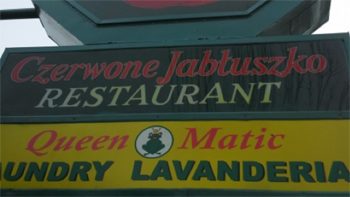In many ways, a city neighborhood has a personality of its own. From the style of buildings to the signs above shops, neighborhoods reflect the cultural identity of the people who reside there. As cities change, so does the cultural identity of an urban neighborhood.
Associate Professor of Geography John Kostelnick is helping students understand the basic concept of “human geography,” with a project that is characterizing the ongoing cultural shifts happening in a Chicago neighborhood.
“The study of human geography can take on many forms,” said Kostelnick. “Human geographers study human culture and activity, which can encompass everything from international trade between countries, to geographic patterns of race or ethnicity in a city. An urban neighborhood is a great place for students to see several concepts of human geography in action, especially topics related to cultural interaction and change. And Chicago’s Milwaukee Avenue provided us that glimpse.”
As part of a research project for Kostelnick’s Geography of Chicago class, students examined a two-mile stretch of the avenue in Chicago’s Logan Square neighborhood which is undergoing a cultural transition today. “Really, what is happening there is a microcosm of what many cities are experiencing, or have experienced in the past,” he said.
Since the late 19th century, Milwaukee Avenue has been the final destination for large waves of Polish immigrants coming to Chicago. “In fact, although Polish migration has slowed considerably today, Chicago is still characterized as the second largest city of Polish people outside of Warsaw, Poland,” noted Kostelnick, whose class traveled to Milwaukee Avenue to observe the architecture that still resembles old European cities, and shops with signs in Polish.
Yet dotted among the historically Polish neighborhood are a new set of residents. Beginning in the past few decades, more shops and businesses have appeared with signs in Spanish as Latino immigrants from Mexico, Cuba, Central America and South America have migrated to Chicago. As established Polish migrants have moved to the suburbs, the result is a culturally diverse landscape. “This is a neighborhood in cultural transition,” said Kostelnick. “You will see a Latino grocery store with a sign in Spanish right next to a Polish restaurant.”

A piece of a map created by John Kostelnick’s geography students showing the transition of businesses along Chicago’s Milwaukee Avenue.
The transition is a familiar one that plays itself out often in many urban areas, Kostelnick said. “International migrants often move into an ethnic neighborhood for cultural familiarity when they first arrive in a new city. As they become more financially secure and learn English, they may move to the suburbs for other opportunities. This leaves empty spaces for businesses and apartments where new immigrants of a different cultural background might move in, and the process repeats,” he said. “It’s the changing nature of urban, human geography.”
To characterize the cultural change in the neighborhood, Kostelnick had his students map ethnic businesses along the avenue. Students were also tasked to explore how the different cultures are integrating by visiting with residents and business owners. “There is still a great deal of segregation in the neighborhood. Many residents are respectful and tolerant of the other cultures, but people still tend to cluster in their own cultural groups and often there is not a lot of interaction,” he said.
The information Kostelnick and his students gathered could be of use to city planners, such as school districts that might need to prepare for student needs, or city councils interested in the changing face of neighborhoods. “Every city goes through changes, we hope these maps and information provide a useful snapshot of the neighborhood today,” said Kostelnick.
Kostelnick believes the greatest advantage students have gained from the project is an understanding of the dynamic of cities. “Cities are rarely static. They are always changing and evolving,” he said. “It is important that students can see the change happening in front of them and put that change into context.”

